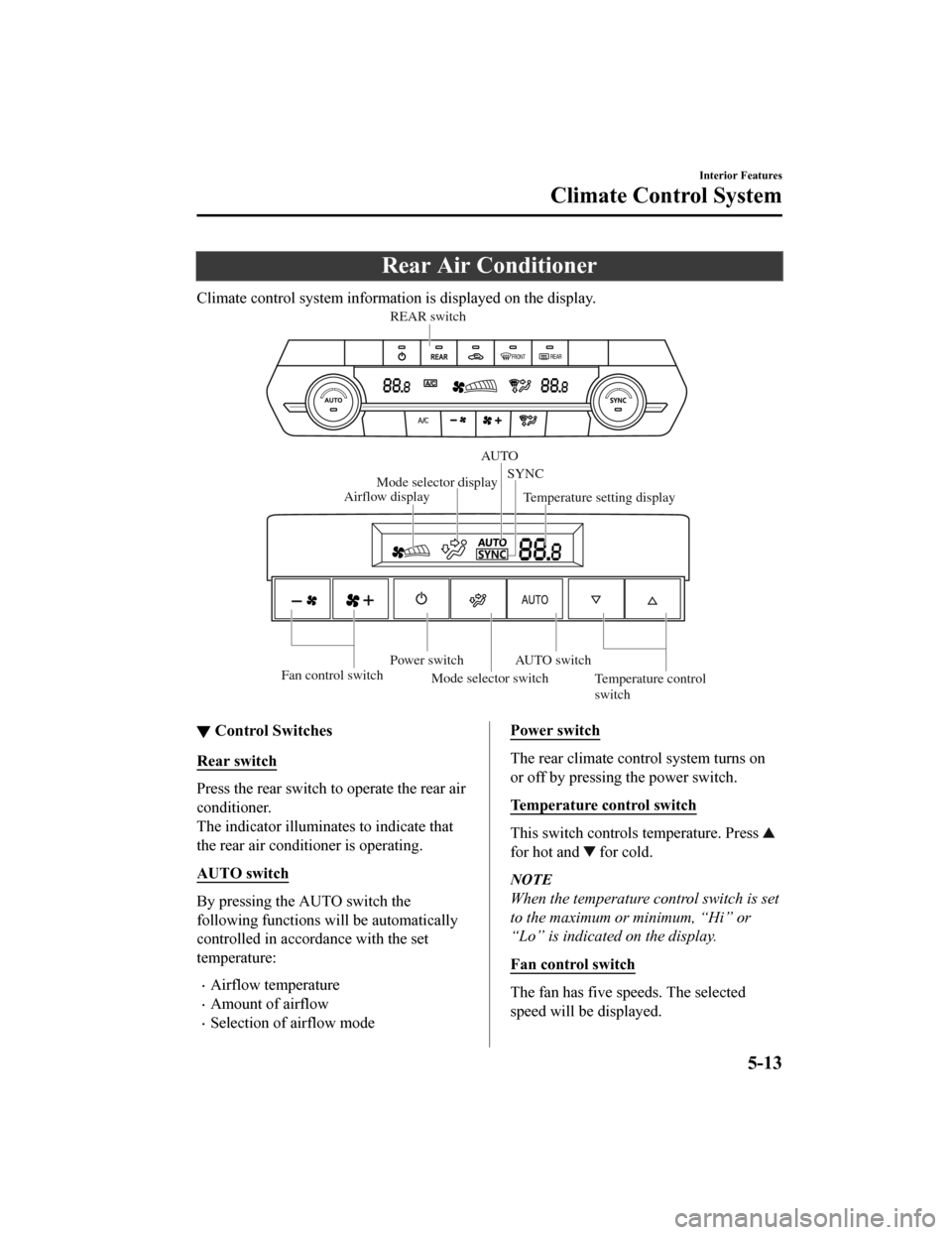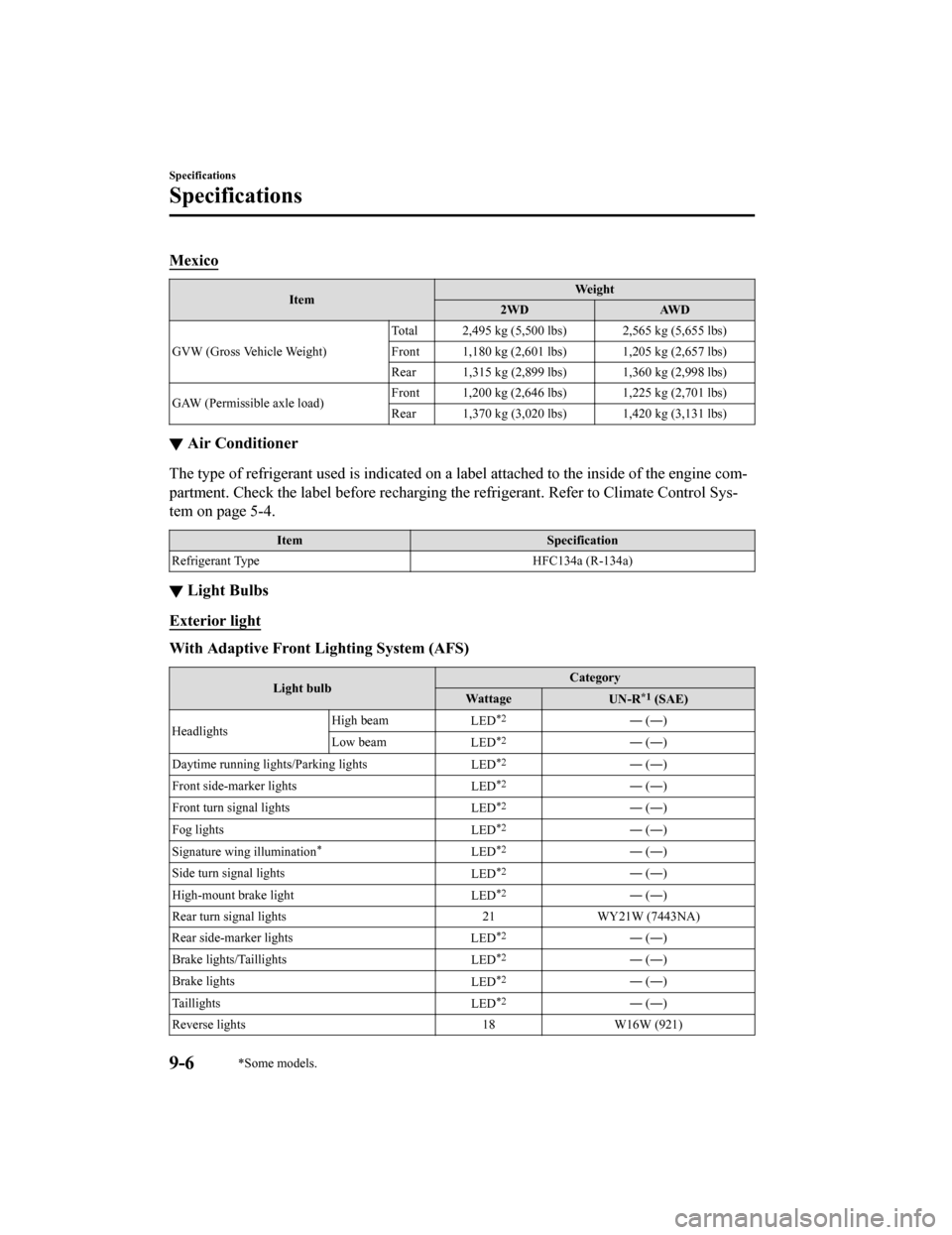climate control MAZDA MODEL CX-9 2019 (in English) User Guide
[x] Cancel search | Manufacturer: MAZDA, Model Year: 2019, Model line: MODEL CX-9, Model: MAZDA MODEL CX-9 2019Pages: 692
Page 400 of 692

▼Selecting the Airflow Mode
Dashboard Vents
Dashboard and Floor Vents Floor Vents
Interior Features
Climate Control System
5-12
CX-9_8HB2-EA-18G_Edition1
2018-5-11 13:09:27
Page 401 of 692

Rear Air Conditioner
Climate control system information is displayed on the display.
Mode selector switch
Airflow display
AUTO switchTemperature setting display
REAR switch
Mode selector display
Power switch
AU TO SYNC
Temperature control
switch
Fan control switch
▼Control Switches
Rear switch
Press the rear switch to operate the rear air
conditioner.
The indicator illuminates to indicate that
the rear air conditioner is operating.
AUTO switch
By pressing the AUTO switch the
following functions will be automatically
controlled in accord
ance with the set
temperature:
Airflow temperature
Amount of airflow
Selection of airflow mode
Power switch
The rear climate control system turns on
or off by pressing the power switch.
Temperature control switch
This switch controls temperature. Press
for hot and for cold.
NOTE
When the temperature control switch is set
to the maximum or minimum, “Hi” or
“Lo” is indicated on the display.
Fan control switch
The fan has five speeds. The selected
speed will be displayed.
Interior Features
Climate Control System
5-13
CX-9_8HB2-EA-18G_Edition1 2018-5-11 13:09:27
Page 402 of 692

Mode selector switch
The desired airflow mode can be selected.
Refer to Selecting the Airflow Mode on
page 5-12.
▼ Operation of Automatic Air
Conditioner
Operation from front seats
1. Turn the front air conditioner on.
2. Press the rear switch. The rear air
conditioner operates.
3. Selection of the airflow mode, airflow
amount and temperature will be
automatically controlled to the same
temperature setting as the front air
conditioner for the driver's side.
NOTE
If the AUTO switch is pressed while
the front A/C switch is off, the rear
air conditioner operates only to
circulate air.
Setting the temperature to the
maximum high or low will not
provide the desired temperature at a
faster rate.
When selecting heat, the system will
restrict airflow until it has warmed
to prevent cold air from blowing out
of the vents.
When the rear air conditioner is
controlled to the same temperature
setting as the fron t air conditioner
for the driver's side, “SYNC” is
displayed on the rear screen.
When operating the fan switch of the
front air conditioner while the rear
air conditioner is operating
automatically, the airflow amount of
the rear air conditioner may change.
Operation from rear seats
1. Turn the front air conditioner on.
2. Press the AUTO switch. The selection of the airflow mode and airflow
amount will be automatically
controlled.
3. Use the temperature control switch to set the desired temperature.
NOTE
If the AUTO switch is pressed while
the front A/C switch is off, the rear
air conditioner operates only to
circulate air.
Setting the temperature to the
maximum high or low will not
provide the desired temperature at a
faster rate.
When selecting heat, the system will
restrict airflow until it has warmed
to prevent cold air from blowing out
of the vents.
When the rear air conditioner is
operated automatic ally, “AUTO” is
displayed on the rear screen.
When the rear air conditioner is
controlled to the same temperature
setting as the front air conditioner
for the driver's side, “SYNC” is
displayed on the rear screen.
To turn off the system, press the Power
switch.
Interior Features
Climate Control System
5-14
CX-9_8HB2-EA-18G_Edition1 2018-5-11 13:09:27
Page 462 of 692

Voice Recognition
▼Basic Operation Method
Activating Voice Recognition
Press the talk button.
Ending Voice Recognition
Use one of the following methods:
Press the hang-up button.
Say, “Cancel”.
Operate the commander switch or the
center display (only when vehicle is
stopped).
Skipping Voice Guidance (for faster
operation)
Press and release the talk button.
Troubleshooting for Voice Recognition
If you do not understand an operation
method while in the voice recognition
mode, say “Tutorial” or “Help”.
Commands useable anytime during
voice recognition
“Go Back” and “Cancel” are commands
which can be used at anytime during voice
recognition.
Returning to previous operation
To return to the previous operation, say,
“Go Back” while in voice recognition
mode.
Cancel
To put the Bluetooth
® Hands-Free system
in standby mode, say, “Cancel” while in
voice recognition mode.
To prevent a deterioration in the voice
recognition rate and voice quality, the
following points should be observed:
The voice recognition cannot be
performed while voi ce guidance or the
beep sound is operating. Wait until
the voice guidance or the beep sound
is finished before saying your
commands.
Phone related commands are available
only when your phone is connected via
Bluetooth
®. Make sure your phone is
connected via Bluetooth
® before you
operate phone related voice commands.
Music play commands, such as Play
Artist and Play Album can be used only
in USB audio mode.
Do not speak too sl owly or loudly (no
loud voice).
Speak clearly, without pausing between
words or numbers.
Dialects or different wording other than
hands-free prompts cannot be
recognized by voice recognition. Speak
in the wording specified by the voice
commands.
It is not necessary to face the
microphone or approach it. Speak the
voice commands while maintaining a
safe driving position.
Close the windows and/or the moonroof
to reduce loud noises from outside the
vehicle, or turn dow n the airflow of the
climate control system while Bluetooth
®
Hands-Free is being used.
Make sure the vents are not directing air
up towards the microphone.
NOTE
If the voice recognition performance is not
satisfactory.
Interior Features
Audio Set
5-74
CX-9_8HB2-EA-18G_Edition1 2018-5-11 13:09:27
Page 534 of 692

Severe braking
After rotation, inflate all tire pressures to
specification (page 9-8) and inspect the
lug nuts for tightness.
CAUTION
Rotate unidirectional tires and radial tires
that have an asymmetrical tread pattern or
studs only from front to rear, not from side
to side. Tire performance will be reduced if
rotated from side to side.
▼ Replacing a Tire
WA R N I N G
Always use tires that are in good condition:
Driving with worn tires is dangerous.
Reduced braking, steering, and traction
could result in an accident.
Replace all four tires at the same time:
Replacing just one ti
re is dangerous. It
could cause poor handling and poor
braking resulting in loss of vehicle control.
Mazda strongly recommends that you
replace all four tires at the same time.
If a tire wears evenly, a wear indicator will
appear as a solid band across the tread.
Replace the tire when this happens.
New tread Tread wear indicator
Worn tread
You should replace the tire before the band
crosses the entire tread.
NOTE
Tires degrade over time, even when they
are not being used on the road. It is
recommended that tires generally be
replaced when they are 6 years or older.
Heat caused by hot climates or frequent
high loading conditions can accelerate the
aging process. You should replace the
spare tire when you replace the other road
tires due to the aging of the spare tire. The
period in which the tire was manufactured
(both week and year) is indicated by a
4-digit number.
Refer to Tire Labeling on page 8-25.
▼Temporary Spare Tire
Inspect the temporary spare tire at least
monthly to make su
re it is properly
inflated and stored.
NOTE
The temporary spare tire condition
gradually deteriorates even if it has not
been used.
Maintenance and Care
Owner Maintenance
6-40
CX-9_8HB2-EA-18G_Edition1 2018-5-11 13:09:27
Page 535 of 692

The temporary spare tire is easier to
handle because of its construction which is
lighter and smaller than a conventional
tire. This tire should be used only for an
emergency and only for a short distance.
Use the temporary spare tire only until the
conventional tire is repaired, which should
be as soon as possible.
Refer to Tires on page 9-8.
CAUTION
Do not use your temporary spare tire rim
with a snow tire or a conventional tire.
Neither will properly
fit and could
damage both tire and rim.
The temporary spare tire has a tread life
of less than 5,000 km (3,000 miles). The
tread life may be shorter depending on
driving conditions.
The temporary spare tire is for limited
use, however, if the tread wear
solid-band indicator appears, replace the
tire with the same type of temporary
spare (page 6-40).
NOTE
Tires degrade over time, even when they
are not being used on the road. It is
recommended that tires generally be
replaced when they are 6 years or older.
Heat caused by hot climates or frequent
high loading conditions can accelerate the
aging process. You should replace the
spare tire when you replace the other road
tires due to the aging of the spare tire. The
period in which the tire was manufactured
(both week and year) is indicated by a
4-digit number.
Refer to Tire Labeling on page 8-25.
▼ Replacing a Wheel
WA R N I N G
Always use wheels of the correct size on
your vehicle:
Using a wrong-sized wheel is dangerous.
Braking and handling could be affected,
leading to loss of control and an accident.
CAUTION
A wrong-sized wheel may adversely
affect:
Tire
fit
Wheel and bearing life
Ground clearance
Snow-chain clearance
Speedometer calibration
Headlight aim
Bumper height
Tire Pressure Monitoring System
*
NOTE
When replacing a wheel, make sure the
new one is the same as the original
factory wheel in diameter, rim width,
and offset (inset/outset).
For details, contact an Authorized
Mazda Dealer.
Proper tire balancing provides the best
riding comfort and helps reduce tread
wear. Out-of-balance tires can cause
vibration and uneven wear, such as
cupping and flat spots.
Maintenance and Care
Owner Maintenance
*Some models.6-41
CX-9_8HB2-EA-18G_Edition1 2018-5-11 13:09:27
Page 635 of 692

Uniform Tire Quality Grading System (UTQGS)
This information relates to the tire grading system developed by the U.S. National Highway
Traffic Safety Administration for grading tires by tread wear, traction, and temperature
performance.
▼ Tr e a d We a r
The tread wear grade is a comparative rating based on the wear rate of the tire when tested
under controlled conditions on a specified government test cour
se.
For example, a tire graded 150 would wear one-and-a-half times as well on the government
course as a tire graded 100.
The relative performance of tires depends upon the actual condi tions of their use, however,
and may depart significantly from the norm because of variation s in driving habits, service
practices and differences in ro ad characteristics and climate.
▼Traction-AA, A, B, C
The traction grades, from highest
to lowest, are AA, A, B, and C. These grades represent the
tire's ability to stop on wet pavement as measured under contro lled conditions on specified
government test surfaces of asphalt and concrete. A tire marked C may have poor traction
performance.
WA R N I N G
The traction grade assigned to this tire is based on braking (straight ahead) traction tests and
does not include acceleration cornering (turning), hydroplaning, or peak traction
characteristics.
▼ Temperature-A, B, C
The temperature grades A (the hi
ghest), B, and C, represent the tire's resistance to the
generation of heat and its ability to dissipate heat when teste d under controlled conditions
on a specified indoor laboratory test wheel.
Sustained high temperature can cause the material of the tire to degenerate and reduce tire
life, and excessive temperatures can lead to sudden tire failure.
Grade C corresponds to a level of performance which all passeng er vehicle tires must meet
under the Federal Motor Vehicle Safety Standard No. 109. Grades B and A represent higher
levels of performance on the labo ratory test wheel than the minimum required by law.
Customer Information and Reporting Safety Defects
Uniform Tire Quality G rading System (UTQGS)
8-23
CX-9_8HB2-EA-18G_Edition1 2018-5-11 13:09:27
Page 668 of 692

Mexico
ItemWe i g h t
2WD AWD
GVW (Gross Vehicle Weight) Total 2,495 kg (5,500 lbs) 2,565 kg (5,655 lbs)
Front 1,180 kg (2,601 lbs) 1,205 kg (2,657 lbs)
Rear 1,315 kg (2,899 lbs) 1,360 kg (2,998 lbs)
GAW (Permissible axle load) Front 1,200 kg (2,646 lbs) 1,225 kg (2,701 lbs)
Rear 1,370 kg (3,020 lbs) 1,420 kg (3,131 lbs)
▼
Air Conditioner
The type of refrigerant used is indicated on a label attached t
o the inside of the engine com‐
partment. Check the la bel before recharging the refrigerant. Re fer to Climate Control Sys‐
tem on page 5-4.
Item Specification
Refrigerant Type HFC134a (R-134a)
▼Light Bulbs
Exterior light
With Adaptive Front Li
ghting System (AFS)
Light bulb Category
Wat tage UN-R*1 (SAE)
Headlights High beam
LED
*2― (―)
Low beam LED
*2― (―)
Daytime running lig hts/Parking lights
LED
*2― (―)
Front side-marker lights LED
*2― (―)
Front turn signal lights LED
*2― (―)
Fog lights LED
*2― (―)
Signature wing illumination
*LED*2― (―)
Side turn signal lights LED
*2― (―)
High-mount brake light LED
*2― (―)
Rear turn signal lights 21WY21W (7443NA)
Rear side-marker lights LED
*2― (―)
Brake lights/Taillights LED
*2― (―)
Brake lights LED
*2― (―)
Taillights LED
*2― (―)
Reverse lights 18W16W (921)
Specifications
Specifications
9-6*Some models.
CX-9_8HB2-EA-18G_Edition1 2018-5-11 13:09:27
Page 683 of 692

Index
Break-In Period................................. 3-47
C
Capacities............................................ 9-4
Carbon Monoxide............................. 3-28
Cell Phones....................................... 8-20
Center Console................................ 5-102
Child Restraint Categories of child-restraint
systems.........................................2-42
Child-restraint precautions.......... 2-37
Child-restraint system
installation................................... 2-42
Child-restraint system suitability for
various seat positions table..........2-44
Installing child-restraint
systems.........................................2-48
ISOFIX child-restraint systems
(Mexico)...................................... 2-57
LATCH child-restraint systems
(Except Mexico).......................... 2-57
Child Safety Locks fo r Rear Doors... 3-19
Climate Control System...................... 5-4 Front Air Conditioner....................5-7
Gas specifications.......................... 9-6
Operating tips................................ 5-4
Rear Air Conditioner... ................ 5-13
Vent Operation (Front).................. 5-5
Vent operation (Rear).................. 5-11
Collision warning.............................. 7-50
Coming Home Light......................... 4-71
Cruise Control................................. 4-203 Cruise control switc h.................4-203
Cruise main indication (white)/cruise
set indication (green)................. 4-204
Cup Holder........................................ 5-99
Customer Assistance.... ....................... 8-2
D
Daytime Running Lights................... 4-72
Defogger
Mirror...........................................4-79
Rear window........... .................... 4-78
Dimensions.......................................... 9-5
Display...............................................4-11
Distance Recognition Support System
(DRSS)............................................ 4-126
Indication on display................. 4-126
Door Locks........................................ 3-11
Drive Selection................................4-102
Driving In Flooded Ar ea...................3-52
Driving on Uneven Road.................. 3-53
Driving Tips
Automatic transaxle.....................4-67
Break-in period............................ 3-47
Driving in flooded a rea............... 3-52
Driving on uneven road...............3-53
Floor mat..................................... 3-49
Hazardous driving.. ..................... 3-48
Overloading............. .................... 3-52
Rocking the vehicle. .................... 3-49
Saving fuel and protection of the
environment................................. 3-47
Turbocharged vehicles.................3-54
Winter driving............................. 3-50
Dynamic Stability Control (DSC)..... 4-97 TCS/DSC indicator light............. 4-97
E
Electric parking brake (EPB)............ 4-90
Electric Parking Brake (EPB) Warning
Beep...................................................7-48
Emergency StartingPush-starting................................ 7-22
Starting a flooded engine............ 7-22
Emergency Towing Towing description...................... 7-25
Towing hooks............. ................. 7-26
Emission Control System..................3-27
Ending Screen Display....................4-100
10-3
CX-9_8HB2-EA-18G_Edition1 2018-5-11 13:09:27